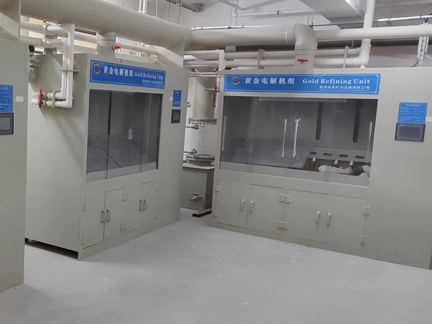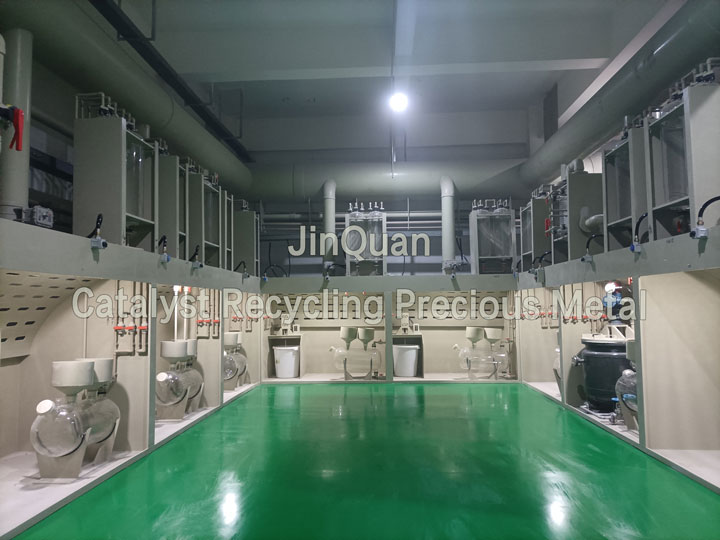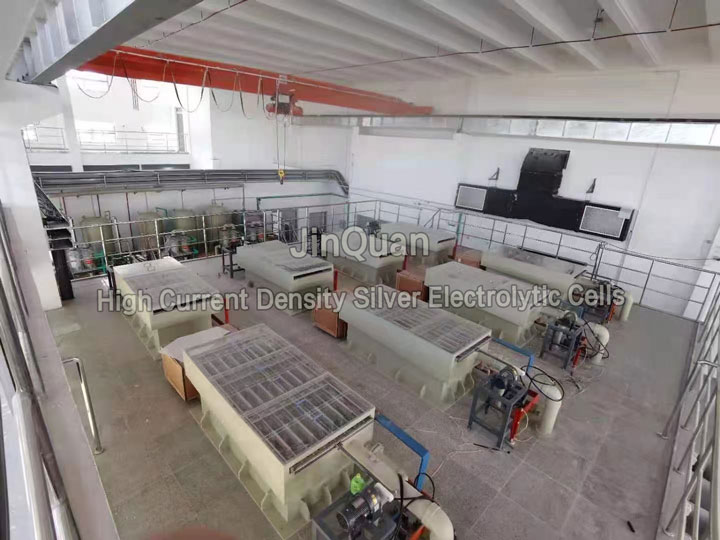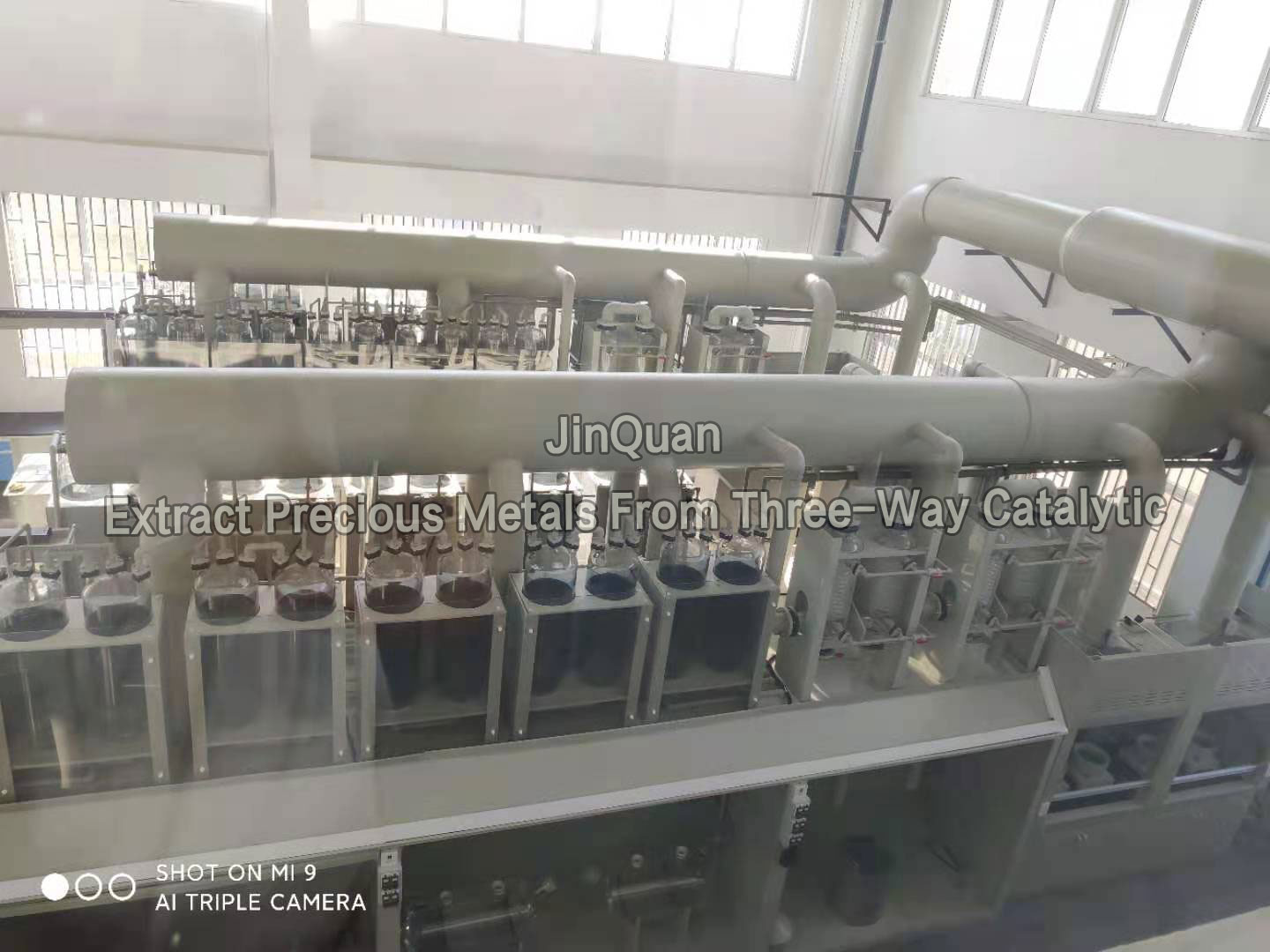 +8613303827570
+8613303827570
The advantages of gold electrolytic unit include:
1、High purity: Electrolytic refining can result in gold purity of 99.99% or higher.
2、High efficiency: Compared to other refining methods, electrolytic refining can extract gold quickly and efficiently.
3、Non-toxic: Most of the chemicals used in the electrolytic refining process are non-toxic and non-hazardous substances, which are not harmful to the environment and human body.
4、Controllable: The process of electrolytic refining can be precisely controlled so that the purity and shape of the gold produced can be adjusted as required.
5、Wide applicability: Electrolytic efining is applicable to all kinds of gold content metals, from high grade gold ores to low grade gold bearing scrap.
Advantages of gold refinery machines:
(1) Casting anode plate: the crude gold raw material with 99% gold content is melted into the medium frequency smelting furnace and cast into a gold electrolytic anode plate.
(2) Electrolyte preparation and waste electrolyte recovery: gold electrolyte is prepared by dissolving pure gold in aqua regia and diluting it with hydrochloric acid aqueous solution.
(3) Electrolysis: hang the anode plate into the gold electrolysis cell and start the gold electrolysis equipment for electrolysis.
The company's high-efficiency gold electrolysis unit (as shown in the figure) is developed based on years of experience in gold refining projects and customer suggestions. It adopts integrated and integrated design. The whole machine includes a single electrolytic cell, circulating pump, rectifier power supply, automatic electrolyte replenishment system, electrolytic flue gas condensation recovery system, electrolyte temperature, voltage, current The copper bar temperature intelligent monitoring system, the rectifier power supply is closed separately, isolated from the acid gas in the workshop, and has a long service life.
With a number of domestic patents and advanced technology, it has the following advantages:
① The product quality is stable and can meet the gold ingot standard of au99.99 (grade I) of Shanghai Gold Exchange; it can also produce gold ingots with purity of 99.999% according to the special needs of customers;
② Low production cost: about 0.02 yuan / gram gold;
③ The electrolysis adopts AC / DC superimposed power supply, which can effectively inhibit the generation of silver chloride on the gold anode and make the anode plate electrolysis more thorough;
④ High current density electrolysis technology; cathode current density up to 1200A / m2, high production efficiency;
⑤ The electrolytic cell is designed with a transparent closed smoke cover to prevent smoke from escaping, which is easy to operate and beautiful;
⑥ A flue gas condensing device is set. Due to the high temperature (60-70 ℃) required by the gold electrolysis process, the flue gas condensing device can condense the reflux volatile electrolyte to avoid the loss of gold;
The main material of the equipment is high performance polypropylene material, adding anti-aging agent to the material, which greatly prolongs the service life of the equipment. The whole bracket material is PPH, and the corrosion resistance is very strong; the cathode and anode conductive bar material is titanium coated copper with excellent conductivity.
This set of gold electrolysis unit is designed with PLC automatic operation system, controlled by touch screen, and has the function of electrolytic parameter storage. When the electrolytic voltage, current and copper bar temperature are abnormal, the rectifier power supply can be directly interlocked to stop. The whole set of equipment is simple, safe and convenient.
model number | external dimensions | ability to precipitate pure gold | power(kw) | power supply | material |
JQ-JDJ-2.5 | 1000*700*1800mm | 2.5kg/d | 2 | 380V | PPH |
JQ-JDJ-5 | 1000*700*1800mm | 5kg/d | 2 | ||
JQ-JDJ-10 | 1100*700*1800mm | 10kg/d | 4 | ||
JQ-JDJ-20 | 1700*800*1800mm | 20kg/d | 6 |
-
 Recovering palladium Carbon Catalyst ProcessRecovering palladium Carbon Catalyst Process
Recovering palladium Carbon Catalyst ProcessRecovering palladium Carbon Catalyst ProcessRecovering palladium Carbon Catalyst Process
Thermal Treatment:The palladium carbon catalyst is immersed in a hot water bath and heated to facilitate the decomposition of organic substances within the catalyst, thereby aiding in its recovery.
Acidic Dissolution:The catalyst is submerged in an acidic solution to leach out palladium ions, reducing the organic content.
Basic Dissolution:The catalyst is treated with a basic solution to extract carbon ions, further decreasing the organic material.
Chloride Solution Treatment:The catalyst is placed in a chloride solution to dissolve metal ions, thereby reducing the organic content.
Leaching with Solvent:The catalyst is immersed in a solvent to absorb and remove organic substances, minimizing their presence within the catalyst.
Recovery of Organic Substances:The extracted organic material is collected for reuse, ensuring minimal waste and maximal efficiency.
High-Temperature Decomposition:The catalyst undergoes high-temperature treatment to ensure complete decomposition of organic substances, facilitating effective recovery.
Vapor Extraction:The catalyst is subjected to vapor processing to extract tantalum ions, enabling their reintegration into the catalyst for reuse.
-
 Silver Electrolysis anode slimeHow to Process Silver Electrolysis anode slime
Silver Electrolysis anode slimeHow to Process Silver Electrolysis anode slimeHow to Process Silver Electrolysis anode slime
The anode slime produced during silver electrolysis constitutes about 8% of the anode's weight and typically contains 50%-70% gold and 30%-40% silver, along with minor impurities. Due to the high silver content, this anode slime cannot be directly cast into anodes for further gold electrowinning. Therefore, measures must be taken to reduce the excess silver content and improve the purity of the gold.
There are two main methods for achieving this:Acidic Dissolution Method:The anode slime is immersed in nitric acid, allowing the dissolution of the excess silver while keeping the gold largely undissolved. The solution is then separated into solid residue (containing high-purity gold) and liquid extract (for recycling the dissolved silver). The residual solid can then be cast into anodes for electrowinning.
Second Electrowinning Process:The anode slime is melted into anodes, which are then subjected to a second round of electrowinning to further reduce the silver content. This step improves the gold concentration in the anode slime, often achieving purity levels above 90%.
Additionally, after dissolving excess silver using nitric acid, alternative methods such as King's Water or Chloride Leaching can be employed to recover gold from the solid residue. These methods include water-based and chloride-based gold leaching techniques, both of which are widely used in industrial applications.
-
 Recovering Platinum Group MetalsMethods for Recovering Platinum Group Metals from Used Catalysts
Recovering Platinum Group MetalsMethods for Recovering Platinum Group Metals from Used CatalystsMethods for Recovering Platinum Group Metals from Used Catalysts
Recovering platinum group metals (PGMs) from used catalysts can be achieved through various methods, each offering its own set of advantages and challenges. Below is a summary of these methods along with key considerations:
High-Temperature Volatilization Method:This method involves controlled high temperatures to vaporize PGMs in their oxidized or chlorinated forms. Specialized equipment, such as absorbing devices, is used to collect the volatile metals. Challenges include the need for precise temperature control and potential costs associated with this equipment.
Carrier Dissolution Method:Strong acids (e.g., HCl, H₂SO₄) or bases (e.g., NaOH) are used to dissolve aluminum oxide carriers, leaving PGMs in sludge. While straightforward, this method may leave residual metals requiring further processing.
Selective Dissolution Method:Solvents are employed to selectively dissolve PGMs without fully dissolving aluminum oxide. This approach holds promise for selective extraction, though the effectiveness and reusability of the solvents require verification.
Full Dissolution Method:Involves completely dissolving both carriers and PGMs into a solution, followed by leaching or ion exchange to recover the metals. While efficient, this method may lead to contamination if not handled properly.
Furnace Melting Method:Metals are separated based on their melting points under high-temperature conditions. PGMs typically have higher melting points than aluminum, aiding in their separation. This method requires careful temperature control for complete recovery.
Burning Method:Specifically tailored for carbon-containing catalysts, this method burns the used catalyst to produce slag, which is then leached using water or hydrochloric acid to extract PGMs. Less energy-intensive but may not be suitable for all catalysts.
Considerations:Integration: Each method may necessitate preprocessing and combination with others for complex catalysts.
Cost-effectiveness: Methods like full dissolution or selective dissolution may have higher upfront costs but offer efficiency in recovery.
Scalability: We need to assess which methods can handle large volumes without losing efficiency.
Environmental Impact: Evaluating toxic byproducts and waste streams for sustainable disposal is crucial.
Conclusion:An optimal approach likely involves a tailored combination of techniques suited to the specific nature of the used catalyst. Further research and development are essential to enhance efficiency and sustainability in PGM recovery processes.







